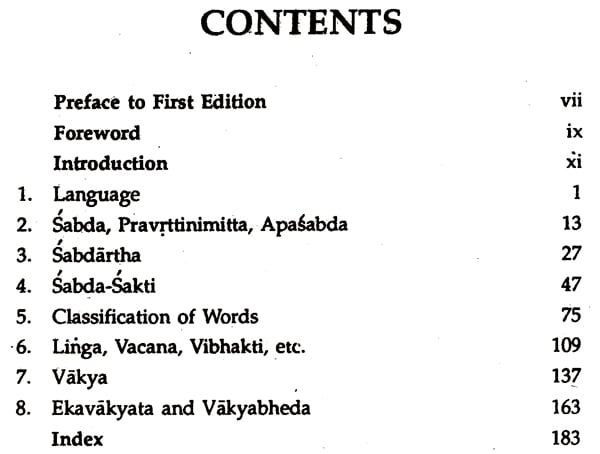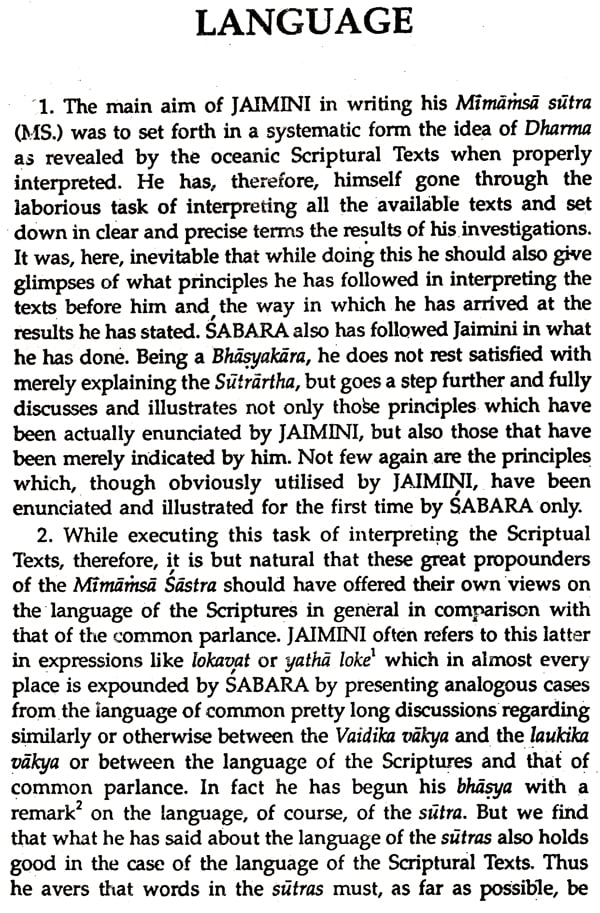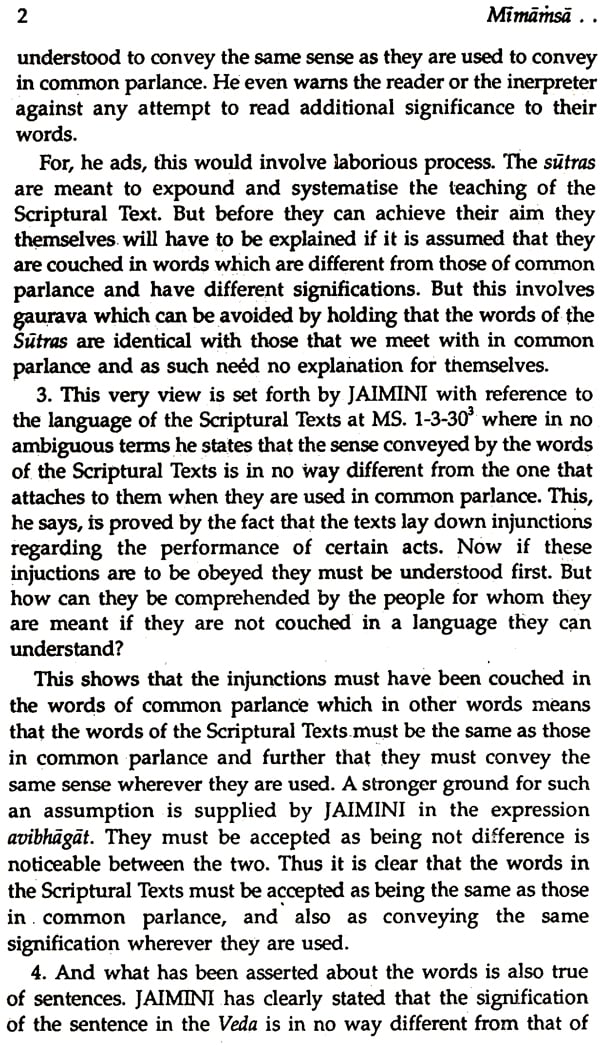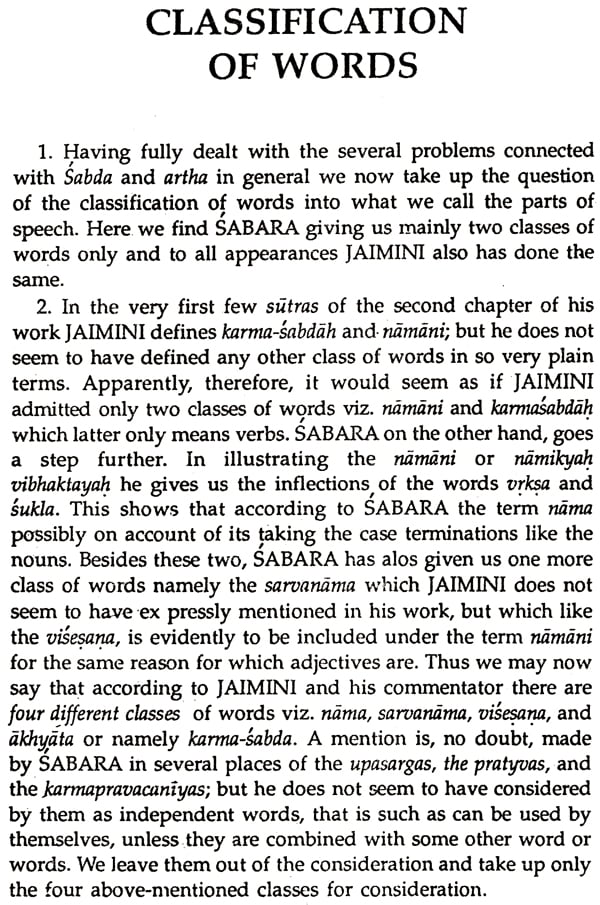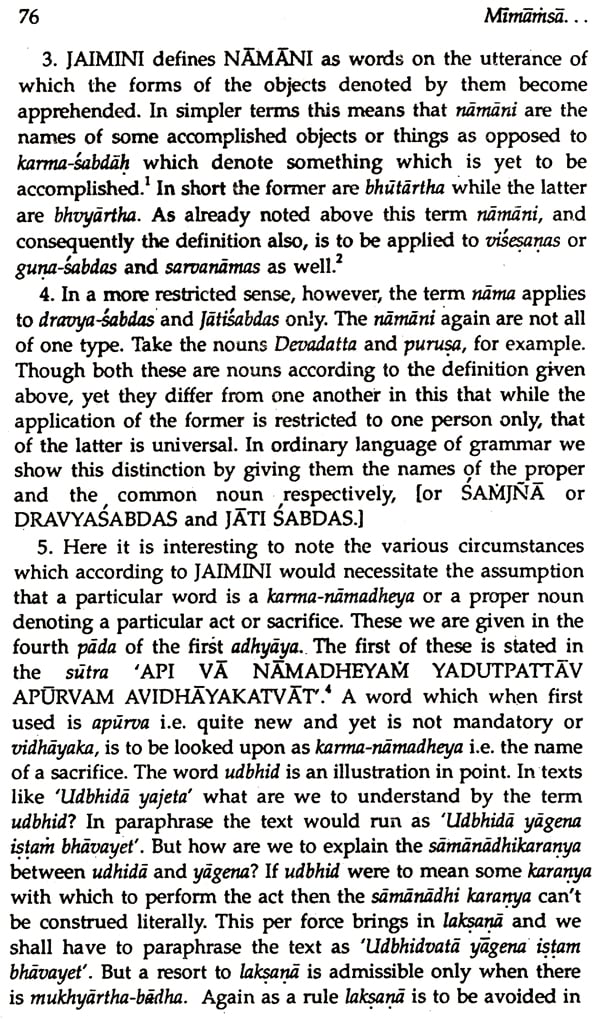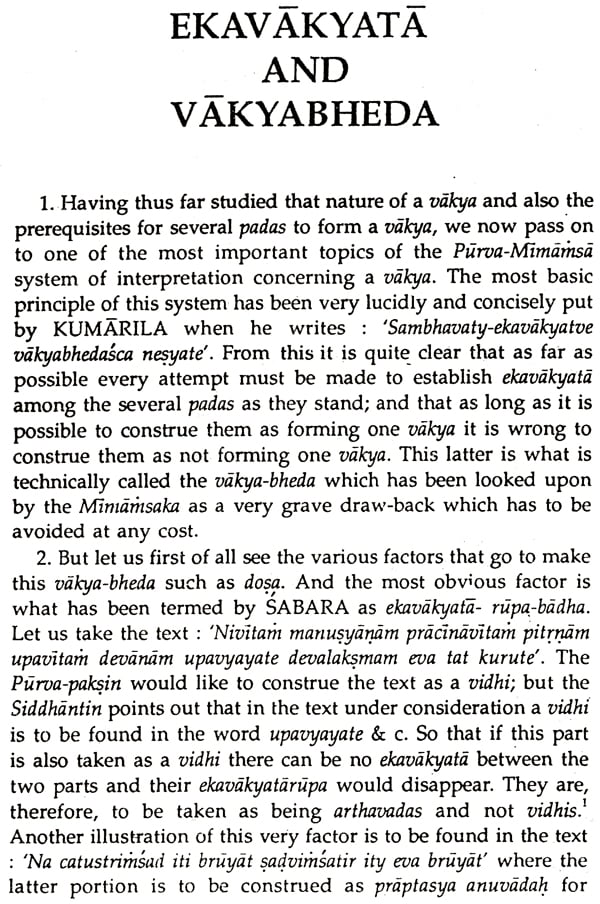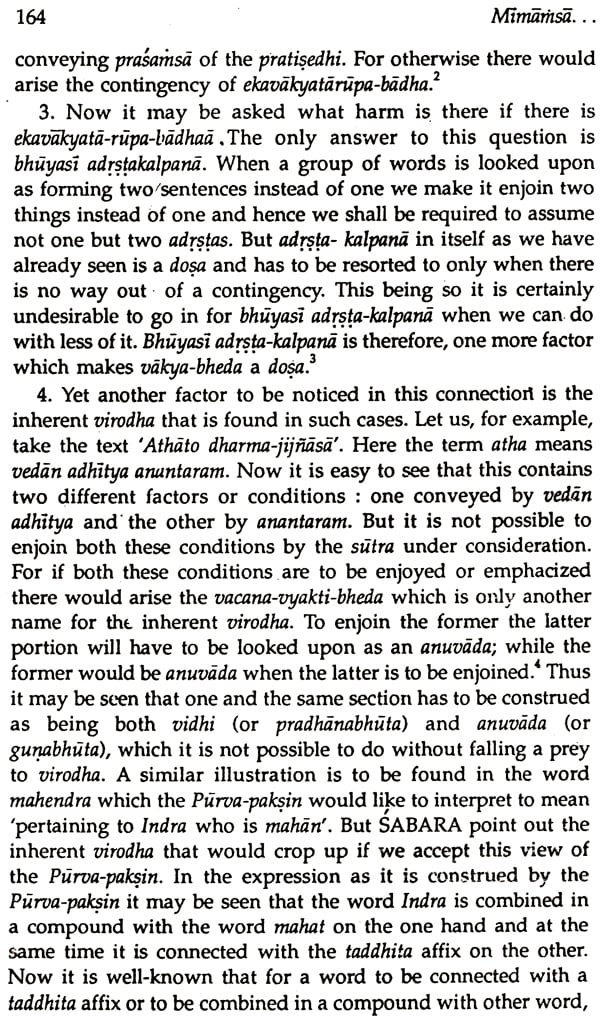
Mimamsa: The Ancient Indian Science of Sentence Interpretation
Book Specification
| Item Code: | NAS413 |
| Author: | G.V. Devasthhali |
| Publisher: | Sri Satguru Publications |
| Language: | English |
| Edition: | 2011 |
| ISBN: | 8170302722 |
| Pages: | 204 |
| Cover: | HARDCOVER |
| Other Details | 9.00 X 6.00 inch |
| Weight | 350 gm |
Book Description
The Vedas are the earliest and the most authentic record of human civilization in India and are the sources of all our knowledge. It is indeed the knowledge. Itself in all its entirely. It was therefore very necessary to lay down rules to preserve the integrity of the Vedas along with its correct and authentic interpretation. With this purpose in view the great thinker of the past composed the Purva-Mimathsa-kistra. It is said that without the help of Purva-Afimathsa, proper study of the Veda is not possible. This book contains almost all the important philosophical aspects of Sabda for the proper understanding of the interpretations of the great writers on the system.
The present book is divided into 8 chapters. They are Ch. 1 - Language; Ch. 2-Sabda, Pravrttinimitta,Apasabda, Ch. - 3 Sabdcirtha; Ch. - 4 Sabda-sakti; Ch. - 5 Classification of Words; Ch. - 6 Lifiga, Vacana, Vibhakti etc.; Ch. - 7 Vakya; Ch. - 8 Ekavakyata and Vakya bheda. The present book set forth systematically the 11Kmathsei views on Language, Word and Sentence, particularly as discussed or suggested by Jaimini and gabara. This edition contains a detailed introduction by Prof. V. N. Jha.
Prof. G. V. Devasthali (b. 1906), was Professor at C.A.S.S. (University of Poona, and Research Professor at Bandarkar Oriental Research Institute, Poona. Prof. Devasthali imbibes the true and honest spirit of Indian Culture without which it is impossible to understand the lines of thinking of the great Rsis of our country. He is the author of many learned articles and books.
It was when I read the Vidhi-pada with my Honours students that I got interested in the study of the Mimamsa-sastra; and a happy mould was given to this interest of mine by my revered Guru, Professor H.D. Velankar, who instructed me to work out the subject Wimiirizsd, the Vakya-gastra of Ancient India'. It was at his instance and under his inspiring guidance that I have worked out the whole thesis, investigating in detail the claim of the Piirva-minuiMsd to the title of Vakya4dstra. In doing this I have restricted myself mainly to the oldest work on the subject (The Mimarksd-sutra of Jaimini) and the oldest extant commentary thereon (The Bhiisya of Sabara). Occasionally, however, I have also referred to some later works on the subject such as the Sloka-viirtika, the Tantra-vartika, and the 7:uptikti by Kumarila, the Nyiya-miilii-vistara of Madhava, the Mirnalitsd-nydya-prakesa of Apadeva and the Artha-saingraha of Laugdksi Bhaskara. The present work, as even a casual glance through the table of contents will make it clear, is an attempt to set forth systematically the Mimainsa views on Language, Word, and Sentence, particularly as discussed or suggested by Jaimini and Sabara.
For my work I have laid under contribution the enlightening works of the late Dr. Ganganath Jha, and also that of the late Dr. A.B. Keith, a constant reference to which has helped a great deal to solve many a knotty point and given a definite shape to several hazy notions. Thanks are also due to Maharnaho-padhya-ya, Dr. Umesha Mishra, M.A., D. Litt., Ex- Director, Mithila Research Institute, Darbhanga, Professor of Sanskrit, Allahabad University, a well-known Mimariisist and disciple of Sir Ganganath Jha, for being kind enough to write a Foreword to this work. Norcan I forget here Shri D.M. Tilak who merely out of friendship has undertaken the publication of work that would perhaps mean more expenditure than gain.
The Lion's Share of credit of whatever may be found to by worthy of it in the present work must, however, go to my revered Guru who has been a perpetual guide to me, and but for whose encouraging words, I am afraid, it would never have been possible for me to carry to completion the present work. At the same time, however, I have to claim all responsibility for whatever defects (including the several misprints) have remained and crept into my work inspite of all the care bestowed on it.
It is a matter of great pleasure to me to have been asked to write a Foreword to this very important work of Indian thought which was supplicated by Dr. G.V. Devasthali, M.A., Ph. D., as a thesis for a doctorate degree to the University of Bombay in 1946 under the title Mimdinsii the Vdlcyagastra. It is a well-known fact that the proper study of the Pdrva-Mimiritsa has been practically neglected for the last four or five centuries even in Mithila, its very home of origination. We know what a great popularity the subject had even in the 15th century during the reign of Bhairavendra Sirinha of Mithila when in course of a Gitugcarana-Yaga of a tank 1400 Mimarnsakas had been invited to attend and witness the Yaga. But at the same time it is a matter of great satisfaction that the tradition of the study of Mimarnsa and also of the performance of sacrifices has been preserved in the South by the sincere votaries of the Veda. It is a fact which does not require any proof that the Veda is the earliest and the most authentic record of human civilization in India and is the source of all our knowledge. It is indeed the knowledge itself in all its entirety. It was, therefore, very necessary to lay down rules to preserve the integrity of the Veda along with its correct and authentic interpretation. With this purpose in view the great thinker of the past composed the Pfirva-Mimainsi-gastra. So has been said by Bhatta -
In fact, Mimamsa-Sastra is as important as the Veda itself; it is, therefore, that it has been said that 'Mimi-41M pratyri-Minarnsii sannatvena Vedaikadegabhatatve. Without the help of this gastra, proper study of the Veda is not possible. Hence, they say that Vicarasandyo hi sabdah svarthath niraludidcsath prabodhayitum ksamah.
This is the purpose why Dr. G.V. Devasthali took up the critical study of Piirva-Mimarhsa and presented his investigations through his thesis Mir-d:nth, the Vakyagastra. This work is now presented to the scholars in the form of a book. It contains almost all the important philosophical aspects of Sabda for the proper understanding of the interpretations of the great writers on the system. Dr. Devasthali is fully qualified to undertake this strenuous and at the same time most responsible task. He is himself brought up in the tradition and has been under the expert guidance of Professor H.D. Velankar of Bombay. Dr. Devasthali imbibes the true and honest spirit of Indian Culture without which it is impossible to understand the lines of thinking of the great Rsis of our country. He approaches the subject and problems connected with it as a and puts forth his investigations very honestly. He has supported all his statements with proper quotation from and references to the Akara texts. This book will really serve the very basic purpose for the proper understanding of the problems of Mima-rhsa and I am glad that Dr. Devasthali has been able to acquit this task so successfully and has tilled up a great desideratum.
The history of development of scientific thinking in ancient India has a very interesting picture. It is interesting because it is a rare example of a historical fact that all these scientific developments have taken place only because all the attempts were made to preserve what can be called the Vedic culture. The Vedic culttire was primarily a ritual culture. This ritual culture was based on some sacred texts, i.e. the Vedas. In other words, the then society cherished the continuation of the Vedic ritual culture, the authority of which happen to be the Vedic texts.
The history tells us that there was a time when the people of the Vedic society at some period of time wanted to have justification for the continuity Of the ritual culture. Naturally, the people of the then society must have been divided into two groups, one group trying to defend the continuity. For the defenders what was- required was to established the authoritativeness of the Vedic text on which the ritual culture depended. The defenders might have adopted various ways and means to achieve this goal and we all know that these attempts to ascribe authoritativeness to the Vedas resulted' into the development of various philosophical systems in ancient India. Once they could achieve the logical defence for the continuity of the ritual culture, the next problem which the defenders must have faced was of preserving and intepreting the sacred texts. To preserve the texts, particularly the Sarhhitas, they discover various methods known as pathas and Vikrtis. This process necessitated the knowledge of the system of sound production and realisation which slowly gave birth to the scimce of Politics in the form of the Pratgakhyas and siksas.
The continuity of the ritual culture further demanded the thorough understanding of the Vedic texts. Because without that the performances could not have been possible. This, in turn, needed the thorough knowledge of grammar of Vedic lanaguage which slowly developed into a fulll scientific knowledge of analysis of language in the form of Panini's Astadhyciyi . To acquire the understanding of the Vedic texts for translating them into action required a system of interpretation of sentences. This attempt gave birth to the Ancient Indian Science of sentence interpretation known as the system of Purva Mirnainsa.
For logical argument the defenders must have felt the need of developing a science of Logic and that must have given birth to the system of Nyaya and Vagesika and all other logical thinking that followed later. Slowly and slowly the defenders must have entered into various problems of Truthand Reality and the Aim of life and this exercise must have resulted into various systems of Indian Philosophy and the Carva'ka Philosophy and the Philosophy of Grammar propounded by Bhartrhari in a more systamatic form.
The time has come to look at this development from this angle. It is indeed amazing to see how mere attempts to preserve what is good and what is nourishing to one's social and spiritual life gave birth to various scientific disciplines in ancient India. The very scientific way of analytic thinking is a contribution, according to me of that glorious past.
Mimariisa system has been enjoying the status of a science of sentence-interpretation. No systimatisors and founders of various philosophical systems of India could afford to ignore this 'system, because this was the only tool available for interpreting a text.
The picture of study of Mimarnsa was quite encourging even upto the 15th Century. As Dr. Umesh Mishra records in his Foreword to the present volume "During the reign of Bhairavendra Siritha of Mithila when in course of a Catugcararia-Yaga of a tank 1400 Mimariisakas had been invited to attend and witness the Yaga". Even after the last generation the study of Mimarinsa was very popular in the southern part of our country. The present state of study of Mimariisa- is, however, very much alarming. Very few traditional scholars, that too belonging to southern India, have been left, who are in the later half of their life. The gradual change of our attitude towards life from spirit to matter, the alurement of the gradual indifference of the policy makers of our higher education and the lack of education towards the study of our cultural heritage which is encoded in Sanskrit language have been responsible for such state of the study of Piirva Mimarnsa. It is this reason that we can count only a few in this century who have taken keen interest in the study of this system of Indian Philosophy. Had MM Ganganath Jha not taken the study of the system seriously, even the present state of interest in the study of Pfirva Mimatilsa would not have been there! Prof. G.V. Devasthali's present work is another such attempt for a serious study of this system. The present work is a fine specimen of a very serious and deep study of Piirva-Mimatiisar in its proper perspective.
I am, therefore, extremely happy that the Indian Books Centre has sholvn keen interest in bringing out the reprint of Prof. Devasthsh's book. The book was presented in 15 chapters. The present volume has re-arranged those chapters into 8 chapters as can be seen from the table of contents.
Prof. Devasthali is net unknown to the world of Sanskrit scholars. He is one of those who gave life to the scientific study of Sanskrit in this century. It is a matter of great satisfaction for me and for all the lovers of Sanskrit that Prof. Devasthali gave permission for the re-print of this volume. I can say unhesitatingly that the book is a mine of minute information from the Akara-Granthas of Ptirva-Mimarnsa. I have no doubt in my mind that scholars will welcome this volume with great interest which will help the revival of the study of Parva-Mimarnsa once again. The Indian Books Centre rightly deserves our thankfulness for presenting this volume to us.
**Contents and Sample Pages**
